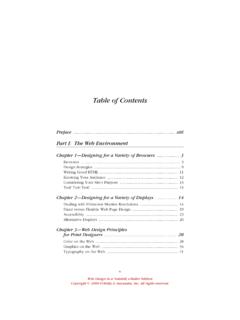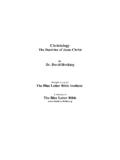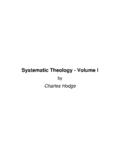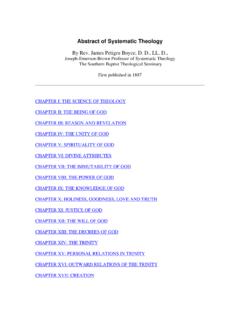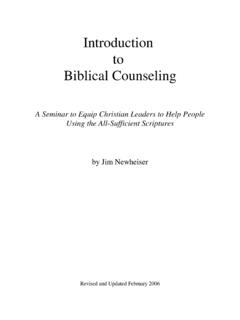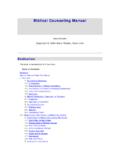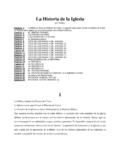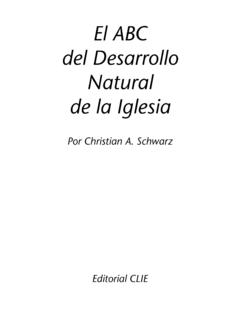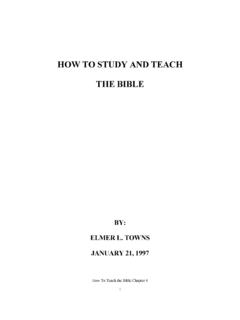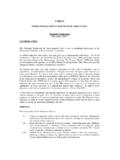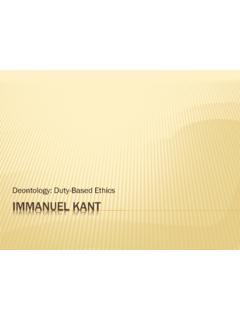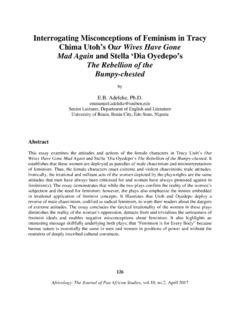Transcription of A Historical Introduction to the New Testament - …
1 A Historical Introduction to the New Testamentreturn to religion-onlineA Historical Introduction to the New Testament by Robert M. GrantRobert M. Grant is professor of New Testament at the University of Chicago, A formost scholar in the field, his books include Gnosticism, The Earliest Lives of Jesus, and The Secret Sayings of Jesus. Copyright 1963 by Robert M. Grant. Originally published by Harper and Row in 1963.(ENTIRE BOOK) Grant deals historically with the New Testament writings. He discusses both the methods used in analyzing and interpreting the New Testament and the conclusions to which they lead. Topics include textual criticism, translation, and literary and Historical criticism. Introduction We are going to try to look logically at many questions concerning the New Testament . Much exegesis of the New Testament has suffered from its lack not of theological but of logical One: ProlegomenaChapter 1: What the New Testament consists of -- The Cannon The New Testament is the product of the Church while the Church is not the product of the New Testament .
2 The church could have proclaimed, and in fact did proclaim, the gospel without possessing the New Testament ; but the New Testament could not have come into existence apart from the 2: Materials and Methods of Textual Criticism The primary goal of New Testament textual study remains the recovery of what the New Testament writers wrote. To achieve this goal is well-nigh 3: The Nature of Translation We face the question of translation: We are not first-century Greeks. We all use translations. Thus we need some clear principles for translating. 1. What did the word mean to the author? 2. What did that word mean to the earliest readers? 3. What has it come to mean in later times? We must avoid a clear defined meaning to all the mysteries of the Bible. We must not place New Testament words and thoughts into an inflexible 4: Literary Criticism 78 (1 of 4) [18/08/2003 09:28:43 ]A Historical Introduction to the New TestamentThe primary function of literary criticism is the understanding of the structure of a document and the reflection of the author s purpose as expressed by means of this 5: Historical Criticism Historical criticism is concerned with the time/place setting of a document, its sources, events discussed in or implied by the document.
3 Historical criticism builds on textual and literary criticism, and its end product is the writing of history, a narrative which reports events in a sequence roughly 6: The Necessity of Theological Understanding There is no particular reason for studying the New Testament over any other collection of ancient documents unless we consider why they wrote. This is the ultimate question of New Testament Two: New Testament LiteratureChapter 7: The Gospels Almost all analysis of when, why, where, and how the gospels were written ultimately fails because it neglects the extent to which the evangelists were involved in the transmission of the Christian tradition as well as the extent to which they were free to arrange and rewrite their materials in ways which seemed meaningful to them and to the communities of which they were 8: The Gospel Of Mark Most of the gospel of Mark consists of materials, apparently derived from oral tradition, concerning what Jesus did and said. To some extent they are bound together by summaries which reflect the evangelist s own view of these 9: The Gospel of Matthew Matthew s own religious interpretation of the story of Jesus points in the direction of an apocalyptic-minded Christianity emerging from Judaism toward the direction of a universalizing 10: The Gospel of Luke and the Book of Acts Although the end was postponed, as Matthew envisioned, we should not agree that it was originally regarded as imminent.
4 Similarly while Luke minimizes Jewish-gentile differences it is possible that in Galatians Paul exaggerates them. The fact that Acts reflects certain purposes on its author s part does not mean that views contrary to those purposes are necessarily authentic, or more 11 The Gospel of John The author was probably not the son of Zebedee but a Jerusalem disciple of Jesus who wrote his gospel around the time of the Roman-Jewish war of 66-70 (probably not long after it) in order to present faith in Christ to bewildered and distressed Jewish sectarians. These sectarians lived either in Palestine itself or in (2 of 4) [18/08/2003 09:28:43 ]A Historical Introduction to the New Testamentthe 12 Aprocryphal Gospels There were many apocryphal gospels in existence as well as the four synoptic gospels. The most important was one ascribed to Peter, the other the Gospel of Thomas. Thomas was discovered in 1945 but not identified until 1952, and was probably written in the first part of the second 13 :The Pauline Epistles The most important goals in studying Paul s letters, are to determine: (1) what the gospel was which he preached and (2) what the nature of the controversies was in which he was 14: The Non-Pauline Epistles We are not altogether justified in treating the Pastorals and Hebrews together, for the objections to the Pastorals have arisen chiefly in modern times; ancient Christians, who in general knew Greek better than we do, had no difficulty in regarding the Pastorals as authentically Pauline, while they regarded Hebrews as written by someone else.
5 We are not altogether justified in treating any of them as non-Pauline, for the Pastorals explicitly represent themselves as by Paul while Hebrews does so by 15: The Book of Revelation We should conclude that the book was written or dictated by an early and significant John, perhaps the son of Zebedee. Two important features of this book are the End Times which dominates it, and the use, throughout the writing, of hymn-like 16: The Writings of the Apostolic Fathers Some of the writings of the Apostolic Fathers were accepted as canonical at a very early date. Among these are the Didache ("The Teaching of the Twelve Apostles"), the letter of Clement of Rome to the Corinthians (I Clement), and the "epistle" of Three: New Testament History and TheologyChapter 17: The Graeco-Roman World Many aspects of the Graeco-Roman world have relevance to Christian origins. These include the Roman Government, the religion of the time, and the considerable emphasis on 18: Palestine In Graeco-Roman Times Only the rise of a new and greater power than those of the then active world could bring some sort of stability to the upheavals of the area and the corridor of Palestine within which many of the military operations took (3 of 4) [18/08/2003 09:28:43 ]A Historical Introduction to the New TestamentChapter 19: The Problem of The Life of Jesus What can we know historically about Jesus?
6 A critique is given in the following areas: Extra-biblical writings, oral tradition, form criticism, Jesus birth, Jesus in the temple, John the Baptist, Jesus baptism, the temptation, Galilee, call of disciples, the apostles, the miracles, Jesus teachings, the transfiguration, the Jerusalem ministry, the Lord s Supper, Good Friday, the rejection of Jesus, and the 20: The Mission of Paul It is impossible to understand early Christianity unless Paul s labors are taken into account. We have two main sources of Paul s work: 1. His letters. 2. His work as described by Luke in the Acts of the 21: The Church in the New TestamentThere are not many references to the "church" in the New Testament . But the existence of the Church is obviously implied by the existence of the oral tradition embodied in the various gospels, as well as by the existence of the gospels themselves. In finding out what the Church meant to early Christians we need to bear in mind the whole of their life, not just the explicit statements they make about the nature of the It has been the attempt of this writing to follow a method likely to produce relatively verifiable conclusions to the documents we possess.
7 The principle virtue of this approach is that it proceeds from the known to the unknown, beginning with the texts we have and proceeding to a literary analysis of them, then to Historical analyses and 20726 times. (4 of 4) [18/08/2003 09:28:43 ]A Historical Introduction to the New Testamentreturn to religion-onlineA Historical Introduction to the New Testament by Robert M. GrantRobert M. Grant is professor of New Testament at the University of Chicago, A formost scholar in the field, his books include Gnosticism, The Earliest Lives of Jesus, and The Secret Sayings of Jesus. Copyright 1963 by Robert M. Grant. Originally published by Harper and Row in The purpose of this book is to deal with the New Testament (and other early Christian literature as reflecting the Historical life of the early Christian Church. This literature was produced in this Church, by members of this Church, for the use of this Church. The Church is the primary Historical reality which stands behind the literature, and without the hypothesis of the Church the literature does not make sense.)
8 The New Testament consists of twenty-seven heterogeneous books which were written at various times and under various circumstances; some of them were accepted and used by Christians almost at once, but as a whole the collection was not universally, or almost universally accepted until the fourth or fifth century. It was the mind of the Church which finally recognized the significance of all twenty seven books as setting forth the basic statement of what the earliest Christianity was. No other literature has anything of value to say about Christian origins and the earliest Christian movement. To be sure there are a few traditions recorded in apocryphal writings or in the works of the Church Fathers, but their Historical or theological importance is practically nil. In so far as they can be checked, they have to be checked in relation to the primary documents which the Church the same time, the primary documents are not self-explanatory, as Christians have recognized since very early times.
9 In our present collection we find four gospels, a book of Acts, fourteen letters ascribed (with varying degrees of plausibility) to the apostle Paul, seven general or catholic letters, and a book of Revelation. This scheme of arrangement does little to indicate the meaning and significance of the various writings. In order to understand them, we must look for the history which stands behind the books. This is to say that we are trying (1 of 7) [18/08/2003 09:28:48 ]A Historical Introduction to the New Testamentto deal historically with the New Testament central Historical problems in relation to the New Testament can be defined in several ways, but before they can be approached we need to consider the periods into which early Church history can be divided. The question of periodization arose in the second century and has been examined by church historians ever since. Generally speaking, historians have differentiated three periods in the life of the early Church: 1) the period of the Incarnation, or the lifetime of Jesus of Nazareth; (2 the apostolic age, from the resurrection or the ascension to the reign of the emperor Nero; and (3) the sub-apostolic age, from Nero s reign to some later date, not usually defined with any clarity.
10 The real significance of this periodization is to be found not in the periods of time involved but in the characteristics of the Church s life in the various periods and in the key events which mark the transitions from one age to another. In dealing with the characteristics and the events we must recognize that there were continuities and discontinuities; there was sameness and change. We must be on our guard against assuming too readily that either sameness or change was dominant. At the same time, we must remember that the community, usually conscious of its self-identity, was likely to lay more emphasis on continuity than can always be justified by the extant texts. The simple chronological periodization mentioned above may obscure significant changes related to the basic directions which the Christian movement we should say something about the primary elements which provided continuity. These were to be found in (1) the relation of Christian disciples to the Old Testament with its revelation of God and its proclamation of his future acts; (2) the relation of Christians to Jesus and the community which he brought into existence, and (3) their life of worship and mission in this community.
